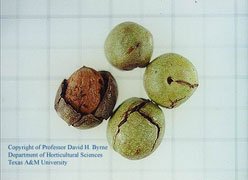


Home
Flowers &
Indoor Plants
Fruits & Nuts
Ornamentals
Vegetables
Special Topics
Resources
Glossary

|
Walnut (English) Juglans regia (jug-lans reg-ee-ah) 
-T23.jpg)
-T21.jpg)
-T22.jpg)
-T29.jpg)
Click on thumbnails for larger image. |
 |
What about it? The name "English walnut" is a misleading one, since this nut originated in the area which is now Iran. It is often called a Persian walnut, and for good reason. The term "Carpathian walnut" is used to describe the cold-hardy strains that performed well in the Ukraine, Russia and Czechoslovakia. The tree is rounded and of medium height, with smooth, whitish-gray bark. Late freezes, extreme cold and spring cold injury limit this crop to only the warmest parts of New York state. What is it used for? Where this tree can be grown, it makes an attractive ornamental as well as a provider of good quality nuts. Unlike the black walnut, the nuts fall free of the husks, and can easily be gathered with a garden rake. When the husks eventually fall, they can be cleaned up with the leaves. The nuts are enjoyed out-of-hand or in baked goods. Where does it grow? How do we grow it? English walnuts require deep, fertile soils that are well-drained. Full sun is necessary for good nut development. Walnuts will set fruit much more slowly if exposed to persistent winds. This type of walnut seems to be a heavy nitrogen feeder, so be prepared to fertilize. Neutral to slightly acid soils are best. What are its primary problems? Bacterial blight, anthramose, leaf spot, cankers, and codling moth are common among the walnut. Rats are a problem with nuts on the ground or in storage. How do we harvest and store it? Walnuts should be picked up as soon as possible after they fall from the tree. Dry nuts can be stored in dry, airy, animal-proof boxes or bins.
© Copyright, Department of Horticulture, Cornell University. |